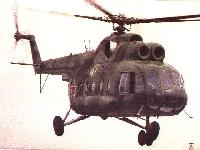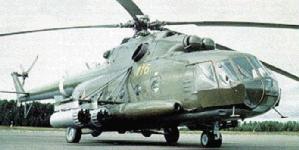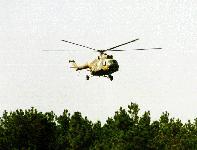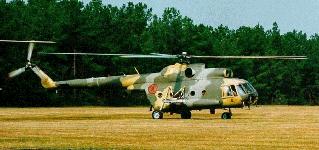FAS |
Military |
DOD 101 |
Systems |
Aircraft |
ROW ||||
Index |
Search |
Join FAS




Mi-17 [Mi-8MT] HIP H
The MI-17 is a multirole helicopter used to resupply CLF guerrillas or insert PSOC detachments. It can also be very heavily armed with an extensive array or rockets, misslies and guns. It is often used to air assault infantry forces to attack the point of penetration, reinforce units in contact or disrupt counterattacks. Additional missions include; attack, direct air support, electronic warfare, airborne early warning, medevac, search and rescue, and minelaying.
The Mi-17 helicopter, developed at the Mil Design Bureau from the Mi-8 helicopter, is in serial manufactured at the Kazan Helicopter Production Association. The designation Mi-17 is for export; the Russian armed forces called it Mi-8MT. The Mi-17 can be recognized because it has the tail rotor at the starboard side, instead of the port side. The Mi-17 added a number of improvements to its predecessor, including a vibration damper to increase comfort for crew members and passengers. The helicopter features a high thrust-to-weight ratio pair of TVZ-117MT or TVZ-117VM shaft-turbine engines with a takeoff power of 1,900 hp. The Mi-17 is capable of single-engine flight in the event of loss of power by one engine (depending on aircraft mission weight) because of an engine load sharing system. If one engine fails, the other engine�s output is automatically increased to allow continued flight.
The Mi-17 is capable of carrying cargoes in the cabin (including long cargo) with half-open or removed doors, external loads, or passengers (24 people). The Mi-17 can carry up to 30 troops and up to 20 wounded; it can also be used for in-flight unloading of special cargoes. The transport version of the MI-17 helicopter is intended to carry cargoes (loads) in the cargo compartment, including long-size cargo with partially- opened or removed cargo doors, external loads, or executives (up to 24 persons). Interior seats are removable for cargo carrying. The rear clamshell doors open, an internal winch facilitates loading of heavy freight. Floor has tiedown rings throughout. The aircraft carries a rescue hoist capable to 150 kg.
External stores are mounted on weapons racks on each side of the fuselage. The Mi-17 has six external hardpoints. The Mi-17 is provided with missiles, bombs, small arms and cannons. It carries four missile launchers of the B8V20 type, with missiles launched with the aid of an on-board PUS-31-71 electrical fire control system. The BDZ-57KRVM bomb carrier is used for the attachment of bombs up to 500kg. Not all vailable munitions are employed at one time, mission dictates weapon configuration. The helicopter carries four UPK-23-250 gun containers with GSh-23L 23mm guns and pivoted mounts (eight units). The forward and aft hemispheres are protected by PKT machine-guns with independent power supply and remote control circuits.
The helicopter may be provided with longrange communication equipment and a radar, and it can carry equipment with phased-array antennas for suppression of enemy electronic attack and air defence facilities, such as airborne radars, air defence (artillery) weapons control radars, surveillance and target detection radars and missile radar homing heads. The ECM equipment can work both in the reconnaissance and ECM modes or in the reconnaissance mode.VARIANTS
- Mi-17: A mid-life upgrade of the widely proliferated Mi-8 HIP H medium assault/ transport helicopter. Initially, only the export version was known as the Mi-17. The only visible differences between this variant and the older Mi-8s is that the tail rotor is on the portside rather than the starboard side, and crew armor plating.
- Mi-17P: A descendent of the HIP K airborne jamming platform characterized by large rectangular antennas along the aft fuselage. The Mi-17P (Mi-8MTPB `Hip-K derivative') is provided with long-range communication equipment and a radar, and it can carry equipment with phased-array antennas for suppression of enemy electronic attack and air defence facilities, such as airborne radars, air defence (artillery) weapons control radars, surveillance and target detection radars and missile radar homing heads. The ECM equipment can work both in the reconnaissance and ECM modes or in the reconnaissance mode.
- Mi-171/-17M/-17V: Also known as Mi-8MTV, and a descendent of the HIP H. The engines are upgraded to 2x 2,070-shp Klimov TV3-117VMAs to allow greater rates of climb and hover ceilings, yet performance characteristics remain virtually unchanged from the baseline Mi-17.
Specifications | |
| Country of Origin | Russia |
| Builder | Mil |
| Date of Introduction | 1981 (as Mi-17) |
| Role | |
| Similar Aircraft | |
| Length |
Length (rotors turning): 25.4 meters Length (fuselage): 18.4 meters |
| Height | 5.7 meters |
| Width | 2.5 meters |
| Main Rotor Diameter | 21.3 meters |
| Tail Rotor Diameter | 3.9 meters |
| Cargo Compartment Dimensions |
Floor Length: 5.3 meters Width: 2.3 meters Height: 1.8 meters |
| Weight |
Maximum Gross: 13,000 kg Normal Takeoff: 11,100 kg Empty: 7,100-7,370 kg (variant dependant) |
| Blades |
Main rotor: 5 Tail rotor: 3 |
| Engine | 2x 1,950-shp Isotov TV3-117MT turboshaft |
| Fuel |
Internal: 445 liters Internal Aux Tank: 915 liters ea. External Fuel Tank: Port Tank: 745 liters Starboard Tank: 680 liters |
| Maximum speed | 250 km/h |
| Cruising speed | 240 km/h |
| Range |
Normal Load: 495 km With Aux Fuel: 1,065 km |
| Ceiling |
Service: 5,000-5,700 meters (variant dependant) Hover (out of ground effect): 1,760 meters Hover (in ground effect): 1,900-3,980 meters (variant dependant) |
| Vertical Climb Rate | 9 m/s |
| Armament |
Most Probable Armament: fitted with 2x 7.62-mm machineguns or possibly 2x 23-mm GSh-23 gun packs in cabin, 57-mm rockets, and AT3/SAGGER ATGMs. Loaded combat troops can fire personal weapons through cabin windows from inside cabin. |
| Standard Payload |
Internal load: 4,000 kg External on sling only: 3,000 kg Transports 24 troops and cargo, or armaments on 6x external hardpoints. |
| Survivability/Countermeasures | Main and tail rotor blades electrically deiced. Infrared jammer, chaff and flares. |
| AVIONICS | The Mi-17 is equipped with instruments, avionics, Doppler radar, and a fully functioning autopilot for operation in day, night, and instrument meteorological conditions. |
| Crew | 3 (2x pilots, 1x flight engineer) |
| Cost | |
| User Countries | At least 22 countries |
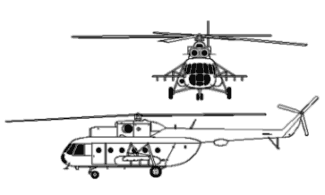
Sources and Resources
FAS |
Military |
DOD 101 |
Systems |
Aircraft |
ROW ||||
Index |
Search |
Join FAS
http://www.fas.org/man/dod-101/sys/ac/row/mi-17.htm
Maintained by Robert Sherman
Originally created by John Pike
Updated Tuesday, September 21, 1999 10:18:15 AM
